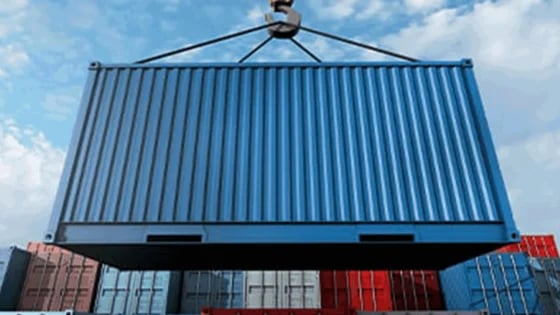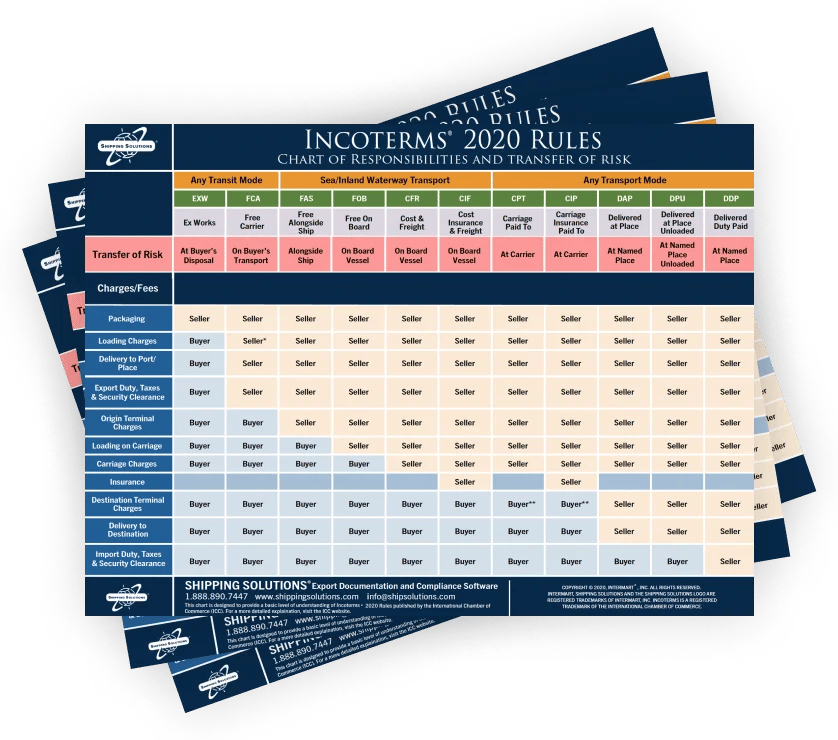The International Trade Blog International Sales & Marketing
Incoterms 2020 DAP: Spotlight on Delivered At Place
On: April 8, 2024 | By:  David Noah |
6 min. read
David Noah |
6 min. read
 Incoterms 2020 rules are the latest revision of international terms of trade published by the International Chamber of Commerce (ICC). They are recognized as the authoritative text for determining how costs and risks are allocated to parties conducting international transactions.
Incoterms 2020 rules are the latest revision of international terms of trade published by the International Chamber of Commerce (ICC). They are recognized as the authoritative text for determining how costs and risks are allocated to parties conducting international transactions.
Incoterms 2020 rules outline whether the seller or the buyer is responsible for, and must assume the cost of, specific standard tasks that are part of the international transport of goods. In addition, they identify when the risk or liability of the goods transfers from the seller to the buyer.
In this article, we’re discussing the Incoterm DAP, also known as Delivered At Place.
There are 11 trade terms available under the Incoterms 2020 rules that range from Ex Works (EXW), which conveys the least amount of responsibility and risk on the seller, to Delivered Duty Paid (DDP), which places the most responsibility and risk on the seller. The Incoterms 2020 Rules: Chart of Responsibilities and Transfer of Risk summarizes the seller and buyer responsibilities under each of the 11 terms.
For a summary of Incoterms 2020 and a short definition of each of the 11 terms, read An Introduction to Incoterms, or watch the video below.
Delivered At Place (DAP) Responsibilities and Risk
Under the Incoterms 2020 rules, DAP means the seller is responsible for all charges and risks in transit until the goods reach their destination, at which point the risk transfers to buyer. Cost and risk transfer from seller to buyer simultaneously at the point the goods are available for unloading. The buyer is responsible for all costs and risks associated with unloading the goods and clearing customs to import the goods into the named country of destination. The buyer selects a customs broker and is responsible for entry fees, duties, taxes, inspection fees and storage fees if goods are not released in a timely manner. The seller must coordinate with the buyer's customs broker to provide any documentation required for export clearance.
Delivered At Place Transportation Options
The ICC has divided the 11 Incoterms into those that can be used for any mode of transportation and those that should only be used for transport by “sea and inland waterway.” Under Incoterms 2020, DAP can be used for any mode of transportation. DAP is ideal for use in multimodal transport.
Using Delivered At Place
When using DAP, it’s important the buyer and seller identify the destination precisely, because both risk and cost transfer at this point. DAP is a flexible term: The named destination could be a port, airport, seaport, the buyer's premise or a border crossing. It does not need to be a freight destination; any named place will work as long as it's a foreign destination or a border crossing. DAP may sound similar to CPT, but this flexibility is one of the primary differences. The other difference is that under DAP the risk of loss stays with the seller until the goods arrive at the named place.
Under this Incoterm, the seller is not required to unload goods unless specified. However, if the seller’s contract of carriage includes unloading the goods at the place of delivery, they may not recover that cost from the buyer unless agreed upon by the buyer.
DAP Frequently Asked Questions (FAQs)
-
What are the risks for buyers when using DAP?
Buyers using DAP are responsible for unloading the goods at the named place of destination and clearing customs for importation. They need to ensure they have the necessary resources, including a competent customs broker, to handle import procedures, entry fees, duties, taxes, inspection fees and potential storage fees if goods are not released promptly.
-
Can sellers choose DAP instead of DDP to reduce risks?
Yes, sellers who want more control over the shipment and to avoid the complexities and risks associated with import duties and taxes often prefer DAP over DDP. By selecting DAP, sellers can still oversee the transportation process while shifting the responsibility for import clearance to the buyer. To learn more, read: Incoterms Comparison: DDP vs. DAP—What's the Difference?
-
Which party is responsible for insurance under DAP?
Under DAP, the seller is not obligated to provide insurance coverage for the goods. However, it is recommended for both parties to agree on insurance coverage to protect against loss or damage during transit.
-
Is DAP suitable for all types of shipments?
DAP can be used for any mode of transportation (it is ideal for us in multimodal transport), but it may not be suitable for every situation. Consider the nature of the goods, the destination country's customs regulations, and the parties' capabilities and preferences when choosing an Incoterm.
-
Is DAP suitable for both international and domestic shipments?
For companies in the United States, Incoterms—including DAP—are primarily used for international trade. Terms defined under the Uniform Commercial Code or more commonly used. However, there is no reason that Incoterms can't be used for a domestic shipment as long as both parties agree to the use of the term chosen. In other regions of the world, Incoterms are more commonly used for domestic shipments. When used domestically, there are some responsibilities defined under each of the terms like customs clearance that are simply ignored because they don't apply.
-
Who is responsible for arranging customs clearance under DAP?Under DAP, the buyer is typically responsible for customs clearance.
-
Can the buyer request additional services or modifications under DAP?
DAP defines minimum obligations and responsibilities of the seller and the buyer. Additional services or modifications beyond these terms can be negotiated between buyer and seller. It's important to clearly document any additional agreements or requirements in the sales contract to avoid misunderstandings.
Learn More about Incoterms 2020 Rules
If you are regularly involved in international trade, you need to understand the risks and responsibilities as defined by Incoterms 2020 rules, not just pick the term you always use. Start by getting a copy of ICC's Incoterms® 2020 Rules book.
For a more detailed understanding of which term or terms make the most sense for your company, register for an Incoterms® 2020 Rules seminar or webinar offered by International Business Training. If you don't want to attend a half-day class, you can get the book provided at these seminars and webinars: Incoterms® 2020 for Importers and Exporters.
Read our articles about all of the other Incoterms 2020 rules here:
- EXW (Ex Works)
- FCA (Free Carrier)
- FAS (Free Alongside Ship)
- FOB (Free On Board)
- CFR (Cost and Freight)
- CIF (Cost, Insurance and Freight)
- CPT (Carriage Paid To)
- CIP (Carriage and Insurance Paid To)
- DPU (Delivered At Place Unloaded)
- DDP (Delivered Duty Paid)
If history is any indication, the Incoterms 2020 rules will be around for at least a decade. Now seems like the perfect time to make sure you understand each of the terms, so you can make sure you’re speaking the same language as your international trading partner.
Like what you read? Subscribe today to the International Trade Blog to get the latest news and tips for exporters and importers delivered to your inbox.
This article was first published in April 2016 and has been updated and revised based on the changes made with the release of the Incoterms 2020 rules.

About the Author: David Noah
As president of Shipping Solutions, I've helped thousands of exporters more efficiently create accurate export documents and stay compliant with import-export regulations. Our Shipping Solutions software eliminates redundant data entry, which allows you to create your export paperwork up to five-times faster than using templates and reduces the chances of making the types of errors that could slow down your shipments and make it more difficult to get paid. I frequently write and speak on export documentation, regulations and compliance issues.


